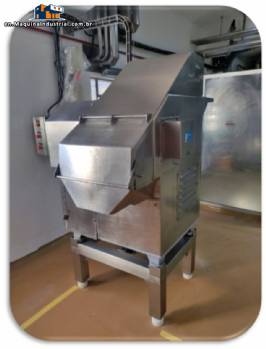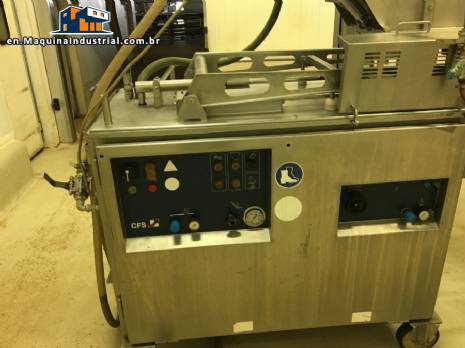Block breakers are industrial equipment used to break large blocks of frozen food, such as meat, fish, vegetables or processed products, into smaller, more manageable portions. These equipments are essential in production processes in food industries, where the raw material arrives frozen in large blocks and needs to be fragmented to facilitate handling and subsequent processing.
The main purpose of a block breaker is to break large blocks of frozen food into smaller pieces, to facilitate their handling and subsequent processing steps, such as cutting, breading, frying or cooking. This equipment is especially useful when the raw material arrives in large, frozen blocks, which would be difficult to work with manually.
Types of block breakers
There are different types of block breakers, depending on the application and the size of the blocks to be processed. Some of the most common types include:
- Meat and fish block breaker:
Equipment designed to break large blocks of frozen meat or fish, such as cuts of chicken, beef or fish fillets. It uses heavy-duty cutting blades to break the block into smaller pieces, making subsequent processing easier.
- Vegetable block breaker:
Used to break up blocks of frozen vegetables, such as carrots, broccoli or spinach, that are frozen in large batches. The equipment makes it easier to separate and prepare the vegetables for the production of processed foods.
- Hydraulic or mechanical block breaker:
Some block breakers use hydraulic or mechanical systems to apply force to the frozen block, breaking it in a controlled manner. This is useful when working with harder products or larger blocks.
- Rotary block breaker:
Equipment that uses a rotating drum with blades or teeth to cut and break the blocks into smaller pieces. This type of breaker is efficient and can handle large volumes of frozen blocks.
- High-pressure block breaker:
Specialized equipment that uses pressure to break up frozen blocks, especially in products such as meat or fish, where breaking must be done without damaging the product.
Benefits of block breakers:
- Ease of handling:
Breaking the blocks into smaller pieces makes it easier to transport and handle food, making the process more efficient and faster.
- Improved productivity:
By automating the block breaking process, production time is significantly reduced, increasing productivity and reducing the need for manual intervention.
- Standardization:
The use of block breakers ensures that all food pieces are of a more uniform size, which helps to improve the quality of the final product, in addition to being important for subsequent processes, such as breading or frying.
- Reduced waste:
The equipment allows for controlled breaking, which reduces food waste and helps to maximize the use of raw materials.
- Food safety:
Automating the block breaking process also contributes to food safety, as manual handling is minimized, which reduces the risk of contamination.
- Increased efficiency in subsequent processing:
Breaking the blocks into smaller pieces allows for faster and more efficient processing in subsequent steps such as cutting, seasoning, breading or frying.
Industries that use block breakers:
A variety of food industries benefit from the use of block breakers, especially those that handle large volumes of frozen products. The main industries that use these equipment include:
- Frozen food industries:
Companies that produce frozen foods, such as meat, fish, seafood and vegetables, use block breakers to break large blocks of frozen product into smaller pieces for easier handling and further processing.
- Meat processing industries:
Manufacturers of processed meat, such as chicken, beef and pork, use block breakers to cut large blocks of frozen meat before further cutting or processing, such as making burgers, nuggets or other products.
- Fish processing industries:
Companies that process frozen fish, such as fish fillets, breaded fish or frozen fish for supermarkets, also use block breakers to break large blocks of frozen fish into smaller pieces.
- Ready-to-eat food industries:
Companies that produce frozen ready meals or other processed products (such as pizzas, lasagnas and ready meals) use block breakers to process frozen ingredients such as meat, vegetables and other items.
- Plant-based food industries:
Industries that produce frozen plant-based products such as broccoli, carrots and other frozen vegetables also use block breakers to separate and process the food efficiently.
- Chicken and poultry industries:
In the chicken sector, especially in large poultry processing plants, block breakers are used to separate frozen chicken into smaller pieces, which makes it easier to handle and cut later.
In short, block breakers are essential equipment for the food industry, especially in processes involving frozen food. They help to improve efficiency, reduce waste, increase productivity and ensure that products are processed uniformly and safely. Frozen food, meat, fish, vegetable and ready-to-eat food companies benefit greatly from this equipment, making it essential in many production lines. |





